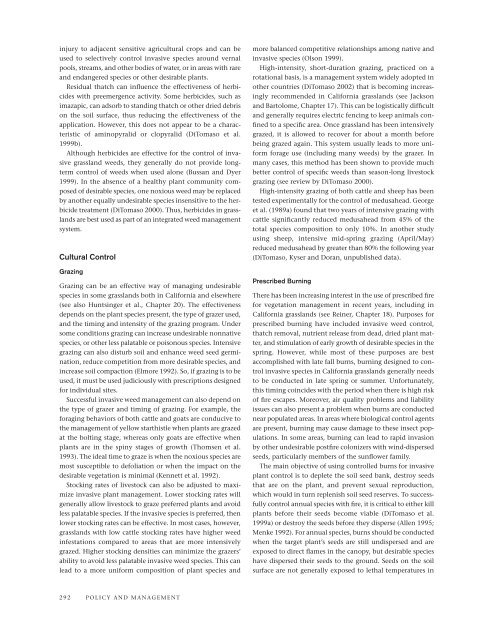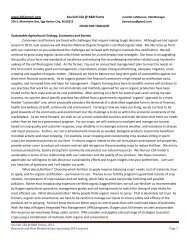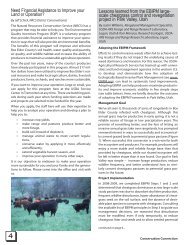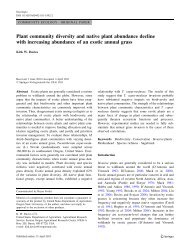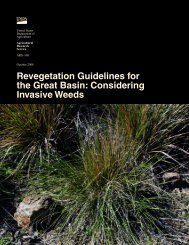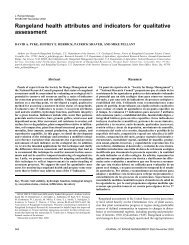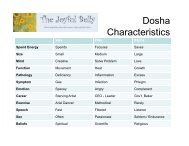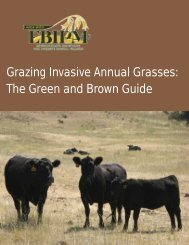Exotic Plant Management in California Annual Grasslands
Exotic Plant Management in California Annual Grasslands
Exotic Plant Management in California Annual Grasslands
You also want an ePaper? Increase the reach of your titles
YUMPU automatically turns print PDFs into web optimized ePapers that Google loves.
<strong>in</strong>jury to adjacent sensitive agricultural crops and can beused to selectively control <strong>in</strong>vasive species around vernalpools, streams, and other bodies of water, or <strong>in</strong> areas with rareand endangered species or other desirable plants.Residual thatch can <strong>in</strong>fluence the effectiveness of herbicideswith preemergence activity. Some herbicides, such asimazapic, can adsorb to stand<strong>in</strong>g thatch or other dried debrison the soil surface, thus reduc<strong>in</strong>g the effectiveness of theapplication. However, this does not appear to be a characteristicof am<strong>in</strong>opyralid or clopyralid (DiTomaso et al.1999b).Although herbicides are effective for the control of <strong>in</strong>vasivegrassland weeds, they generally do not provide longtermcontrol of weeds when used alone (Bussan and Dyer1999). In the absence of a healthy plant community composedof desirable species, one noxious weed may be replacedby another equally undesirable species <strong>in</strong>sensitive to the herbicidetreatment (DiTomaso 2000). Thus, herbicides <strong>in</strong> grasslandsare best used as part of an <strong>in</strong>tegrated weed managementsystem.Cultural ControlGraz<strong>in</strong>gGraz<strong>in</strong>g can be an effective way of manag<strong>in</strong>g undesirablespecies <strong>in</strong> some grasslands both <strong>in</strong> <strong>California</strong> and elsewhere(see also Hunts<strong>in</strong>ger et al., Chapter 20). The effectivenessdepends on the plant species present, the type of grazer used,and the tim<strong>in</strong>g and <strong>in</strong>tensity of the graz<strong>in</strong>g program. Undersome conditions graz<strong>in</strong>g can <strong>in</strong>crease undesirable nonnativespecies, or other less palatable or poisonous species. Intensivegraz<strong>in</strong>g can also disturb soil and enhance weed seed germ<strong>in</strong>ation,reduce competition from more desirable species, and<strong>in</strong>crease soil compaction (Elmore 1992). So, if graz<strong>in</strong>g is to beused, it must be used judiciously with prescriptions designedfor <strong>in</strong>dividual sites.Successful <strong>in</strong>vasive weed management can also depend onthe type of grazer and tim<strong>in</strong>g of graz<strong>in</strong>g. For example, theforag<strong>in</strong>g behaviors of both cattle and goats are conducive tothe management of yellow starthistle when plants are grazedat the bolt<strong>in</strong>g stage, whereas only goats are effective whenplants are <strong>in</strong> the sp<strong>in</strong>y stages of growth (Thomsen et al.1993). The ideal time to graze is when the noxious species aremost susceptible to defoliation or when the impact on thedesirable vegetation is m<strong>in</strong>imal (Kennett et al. 1992).Stock<strong>in</strong>g rates of livestock can also be adjusted to maximize<strong>in</strong>vasive plant management. Lower stock<strong>in</strong>g rates willgenerally allow livestock to graze preferred plants and avoidless palatable species. If the <strong>in</strong>vasive species is preferred, thenlower stock<strong>in</strong>g rates can be effective. In most cases, however,grasslands with low cattle stock<strong>in</strong>g rates have higher weed<strong>in</strong>festations compared to areas that are more <strong>in</strong>tensivelygrazed. Higher stock<strong>in</strong>g densities can m<strong>in</strong>imize the grazers’ability to avoid less palatable <strong>in</strong>vasive weed species. This canlead to a more uniform composition of plant species andmore balanced competitive relationships among native and<strong>in</strong>vasive species (Olson 1999).High-<strong>in</strong>tensity, short-duration graz<strong>in</strong>g, practiced on arotational basis, is a management system widely adopted <strong>in</strong>other countries (DiTomaso 2002) that is becom<strong>in</strong>g <strong>in</strong>creas<strong>in</strong>glyrecommended <strong>in</strong> <strong>California</strong> grasslands (see Jacksonand Bartolome, Chapter 17). This can be logistically difficultand generally requires electric fenc<strong>in</strong>g to keep animals conf<strong>in</strong>edto a specific area. Once grassland has been <strong>in</strong>tensivelygrazed, it is allowed to recover for about a month beforebe<strong>in</strong>g grazed aga<strong>in</strong>. This system usually leads to more uniformforage use (<strong>in</strong>clud<strong>in</strong>g many weeds) by the grazer. Inmany cases, this method has been shown to provide muchbetter control of specific weeds than season-long livestockgraz<strong>in</strong>g (see review by DiTomaso 2000).High-<strong>in</strong>tensity graz<strong>in</strong>g of both cattle and sheep has beentested experimentally for the control of medusahead. Georgeet al. (1989a) found that two years of <strong>in</strong>tensive graz<strong>in</strong>g withcattle significantly reduced medusahead from 45% of thetotal species composition to only 10%. In another studyus<strong>in</strong>g sheep, <strong>in</strong>tensive mid-spr<strong>in</strong>g graz<strong>in</strong>g (April/May)reduced medusahead by greater than 80% the follow<strong>in</strong>g year(DiTomaso, Kyser and Doran, unpublished data).Prescribed Burn<strong>in</strong>gThere has been <strong>in</strong>creas<strong>in</strong>g <strong>in</strong>terest <strong>in</strong> the use of prescribed firefor vegetation management <strong>in</strong> recent years, <strong>in</strong>clud<strong>in</strong>g <strong>in</strong><strong>California</strong> grasslands (see Re<strong>in</strong>er, Chapter 18). Purposes forprescribed burn<strong>in</strong>g have <strong>in</strong>cluded <strong>in</strong>vasive weed control,thatch removal, nutrient release from dead, dried plant matter,and stimulation of early growth of desirable species <strong>in</strong> thespr<strong>in</strong>g. However, while most of these purposes are bestaccomplished with late fall burns, burn<strong>in</strong>g designed to control<strong>in</strong>vasive species <strong>in</strong> <strong>California</strong> grasslands generally needsto be conducted <strong>in</strong> late spr<strong>in</strong>g or summer. Unfortunately,this tim<strong>in</strong>g co<strong>in</strong>cides with the period when there is high riskof fire escapes. Moreover, air quality problems and liabilityissues can also present a problem when burns are conductednear populated areas. In areas where biological control agentsare present, burn<strong>in</strong>g may cause damage to these <strong>in</strong>sect populations.In some areas, burn<strong>in</strong>g can lead to rapid <strong>in</strong>vasionby other undesirable postfire colonizers with w<strong>in</strong>d-dispersedseeds, particularly members of the sunflower family.The ma<strong>in</strong> objective of us<strong>in</strong>g controlled burns for <strong>in</strong>vasiveplant control is to deplete the soil seed bank, destroy seedsthat are on the plant, and prevent sexual reproduction,which would <strong>in</strong> turn replenish soil seed reserves. To successfullycontrol annual species with fire, it is critical to either killplants before their seeds become viable (DiTomaso et al.1999a) or destroy the seeds before they disperse (Allen 1995;Menke 1992). For annual species, burns should be conductedwhen the target plant’s seeds are still undispersed and areexposed to direct flames <strong>in</strong> the canopy, but desirable specieshave dispersed their seeds to the ground. Seeds on the soilsurface are not generally exposed to lethal temperatures <strong>in</strong>292 POLICY AND MANAGEMENT


